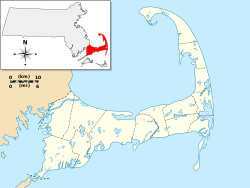South Chatham Village Historic District | |
 South Chatham Community Church | |
| Location | Western portion of Main St., and northern portions of Deep Water Ln., Forest Beach Rd., and Pleasant St., Chatham, Massachusetts |
|---|---|
| Coordinates | 41°40′44″N70°1′36″W / 41.67889°N 70.02667°W |
| Architectural style | Cape Cod, Greek Revival, Queen Anne |
| NRHP reference No. | 100008033 [1] |
| Added to NRHP | August 29, 2022 |
The South Chatham Village Historic District is a historic district encompassing much of the linear village of South Chatham in Chatham, Massachusetts. Extending eastward from the Harwich town line along Main Street, the district developed in the 18th and 19th centuries as a maritime and farming village. The district was listed on the National Register of Historic Places in 2022. [1]



